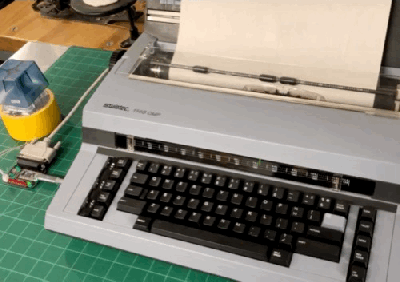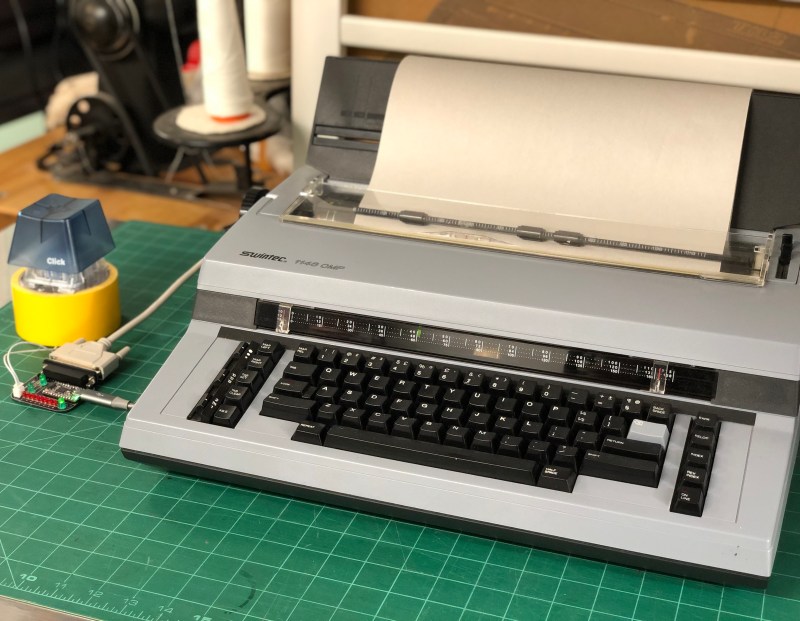If you want to talk to a typewriter using something other than your fingers on the keys, you could do a lot worse than to pick up a specimen featuring a Centronics parallel port. That’s what happened to [mlupo], who came across an old Swintec 1146 CMP and decided to hack it into an art installation.
 At the push of a giant, clicky button, the typewriter now spits out family stories. This is all thanks to an Adafruit KB2040 keyboard driver being used in a new, exciting way — as a printer driver.
At the push of a giant, clicky button, the typewriter now spits out family stories. This is all thanks to an Adafruit KB2040 keyboard driver being used in a new, exciting way — as a printer driver.
More specifically, the CircuitPython program running on the KB2040 takes in a text file and then sends the data one character at a time until a newline is reached. At that point, the typewriter sends a busy signal and the characters are typed.
As soon as the typewriter is no longer occupied, the data stream picks back up until the next newline or until the file is completely typed out.
Once [mlupo] figured out enough of the parallel port protocol, they were able to build a custom breakout board with the KB2040, a female parallel port, and a row of LEDs for debugging that [mlupo] kept because they look cool.
The KB2040 sets the values high on a series of the parallel port’s data pins, along with the port’s STROBE pin, which pulls low when data is ready. During each STROBE cycle, the high and low pins are read by the Swintec as a binary character.
Of course, you can always use the power of Pi to build your own modern typewriter.
Thanks to [foamyguy] for the tip!

















Long time ago, I had a serial terminal daisy wheel printer. Big Wide format tractor feed eating monster built into a desk, with a “clunk” style keyboard on it. Lovely.
I used it as a printer a lot; because it had a readable 8pt? font. tiny. I would run off “Ralph Brown’s Interrupt List” and other references and bind them together into books to sell to people. Ribbons were actually still available for it 12 years after it had been made; I was working for an Epson dealer and we had “bulk printer ribbon” so i refilled a lot.
Most of the time it was sitting idle beside my desk. Sometimes when I had company I wanted to mess with, I’d make it start printing something weird. Great thing to set up just before I popped out to the bathroom or something.
I don’t know why this thought popped into my head, but it strikes me that such an artifact/curiosity, rock solid as it must be, could find a productive home in some sort of long-abandoned-research-station sci-fi themed escape room.
Oh the horror, an escape room with a manual typewriter (no spell check), a dial phone, a TRS80 computer with dial up Internet, all cell phone service blocked, and instructions written in cursive would have the current generation trapped for days. 🤣
And the older generation might not know how to get out of a room if you sold step by step instructions online for a penny and provided them with a tablet – if you required them to figure out how to set it up, get online, sign up for an account, link a payment method, make the purchase, and find the correct download button without help. Twelve-o-clock flashers, eh?
Or alternatively, if I took Google away and gave you a sack, saying we’d use part for hoe or ash cakes tomorrow and parch the rest, would you know what was in it without looking? Would you know that the first part was to be ground up and eaten as a pancake before leaving and the rest was effectively trail mix?
Back in the late 70s/early 80s I saw ads for printer converters which were an array of solenoids you would lay on the keyboard of your typewriter. The computer would then print by sending ASCII to the device which would push the appropriate typewriter key. I remember ads for these things in Creative Computing and Byte and wondered if them could actually work.
It would have to have been an electric typewriter like this. A manual typewriter conversion would be amusing!
Now that’s a hack.
If nothing else, it would be entertaining to watch. For a few minutes.
As a more accurate model of certain people’s typing methods, it might be fun to watch a cartesian X-Y mechanism, using a single solenoid for the z axis, do some one-finger hunt & peck style typing. For a few minutes.
Then again, two R theta/polar coordinate mechanisms would be more entertaining and more analogous to two-finger typing methodology. For a few minutes.
Here is a video of one of those
https://www.youtube.com/watch?v=4_WfQoKRlxE
I recently had a thought about modifying a mouse jiggler to add keyboard functionality. You’d open notepad or something on your work laptop and it would type out a file, a couple characters a second, maybe with fake typos and corrections inserted, in case work is monitoring your activity.
I have a DEC Writer IV set up that’s a typewriter, printer AND terminal! It’s a beautiful piece of equipment and surprisingly I can still buy cartridges for it.
Does the machine have a half line feed option? If so, the ASCII art options improve.
https://www.reddit.com/r/typewriters/comments/nliu53/typewriter_art_question_text_art_with_half_a/
I remember turning a $2500 computer into a dumb typewriter by typing this: type con>lpt (I think it was the DOS command? It had been decades)
Basically dump everything from keyboard directly to printer.
The biggest problem with these ribbon based printers is the foam transport roller in the ribbon cartridges. They turn to dust or goo over the years. NOS cartridges have the same problem.
Swintec is still in business. It seems they mark-up Made in China electric typewriters and sell them at a nice profit to Federal Prisons in the U.S. (or at least inmates in certain prisons).[1] I am pretty sure you can buy one for yourself too![2]
Swintec 2416DM electronic memory and display typewriter… $335.50
Swintec 2410 Typewriter… $249.50
* References:
1. Swintec Corporate Headquarters
320 West Commercial Avenue
Moonachie, New Jersey 07074
Web: https://www.swintec.com
2. Personal Electronic Typewriters
https://www.swintec.com/216-portable-typewriters